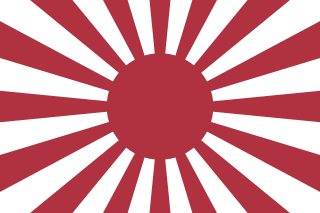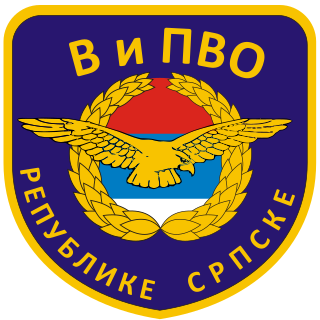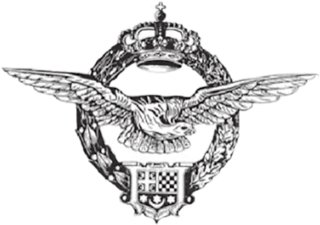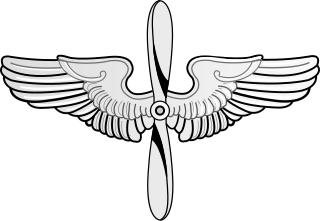 W
WThe Aeronautical Division, Signal Corps (1907–1914) was the first heavier-than-air military aviation organization in history and the progenitor of the United States Air Force. A component of the U.S. Army Signal Corps, the Aeronautical Division procured the first powered military aircraft in 1909, created schools to train its aviators, and initiated a rating system for pilot qualifications. It organized and deployed the first permanent American aviation unit, the 1st Aero Squadron, in 1913. The Aeronautical Division trained 51 officers and 2 enlisted men as pilots, and incurred 13 fatalities in air crashes. During this period, the Aeronautical Division had 29 factory-built aircraft in its inventory, built a 30th from spare parts, and leased a civilian airplane for a short period in 1911.
 W
WThe Air Fleet of the Revolutionary Insurgent Army of Ukraine was one of the branches of the Revolutionary Insurgent Armed Forces.
 W
WThe Air Force of Serbia and Montenegro, also known as the Air Force of Yugoslavia from 1992 to 2003, was the air force of the former Serbia and Montenegro. It had around 300 fighter aircraft, ground attack aircraft, and other aircraft. The air force, in 1998, had about 16,000 personnel. The air force was disbanded when Montenegro voted to secede from the ex-FRY in 2006. The bulk of it was inherited by the Serbian Air Force.
 W
WThe Air Force of the Independent State of Croatia, was the air force of the Independent State of Croatia (NDH), a puppet state established with the support of the Axis Powers on the territory of the Kingdom of Yugoslavia during World War II. The ZNDH was founded under German authority in April 1941, following the German-led Axis invasion of Yugoslavia.
 W
WThe Air Tigers or Sky Tigers was the air-wing of the Liberation Tigers of Tamil Eelam (LTTE), who used it against the Government of Sri Lanka. Though the existence of the Sky Tigers had been the subject of speculation for many years, the existence of the wing was only revealed after an attack in March 2007, during Eelam War IV.
 W
WThe Aviation Section, Signal Corps, was the aerial warfare service of the United States from 1914 to 1918, and a direct statutory ancestor of the United States Air Force. It absorbed and replaced the Aeronautical Division, Signal Corps, and conducted the activities of Army aviation until its statutory responsibilities were suspended by President Woodrow Wilson in 1918. The Aviation Section organized the first squadrons of the aviation arm and conducted the first military operations by United States aviation on foreign soil.
 W
WThe Bophuthatswana Air Force (BAF) was the aviation branch of the Bophuthatswana Defence Force. The BAF existed from 1987 until 27 April 1994. The primary role of the BAF was to provide support and medevac services to the ground units of the Bophuthatswana army. The BAF operated from several bases, one being Mmabatho AFB.
 W
WThe Canadian Air Force (CAF) was a contingent of two Canadian air force squadrons – one fighter and one bomber – authorized by the British Air Ministry in August 1918 during the close of the First World War. The unit was independent from the Canadian Expeditionary Force and the Royal Air Force (RAF).
 W
WThe Czechoslovak Air Force or the Czechoslovak Army Air Force was the air force branch of the Czechoslovak Army formed in October 1918. The armed forces of Czechoslovakia ceased to exist on 31 December 1992. By the end of the year, all aircraft of the Czechoslovak Air Force were divided between the Czech Air Force and the Slovak Air Force.
 W
WThe French Aerostatic Corps or Company of Aeronauts was the world's first air force, founded in 1794 to use balloons, primarily for reconnaissance.
 W
WThe Hejaz Air Force or Hejaz Flying Corps was the aerial component of the armed forces of the short-lived Kingdom of Hejaz and its successor the Kingdom of Hejaz and Nejd. Claiming to be the oldest Air Force on the Arabian Peninsula, the service was a very small entity, numbering at most nine aircraft at any time. It operated intermittently between 1921 and 1932, battling with staff shortages and aircraft availability; often only two aircraft were operational at any time. The personnel came from many nations, with pilots coming from Germany, Greece, Italy, Russia and the United Kingdom, as well as from the kingdom itself after the flight of the first Arab pilot, Abdul Salam Sarhan, in 1923. It provided aerial reconnaissance and bombardment to support the army against the much larger land forces of Ibn Saud during the Hejaz-Nejd War, including bombing attacks on Jeddah and Mecca. Its successor is the Royal Saudi Air Force.
 W
WThe Deutsche Luftstreitkräfte —known before October 1916 as Die Fliegertruppen des deutschen Kaiserreiches abbreviated to Die Fliegertruppe—was the air arm of the Imperial German Army. In English-language sources it is usually referred to as the Imperial German Air Service, although that is not a literal translation of either name. German naval aviators of the Marine-Fliegerabteilung were an integral part of the Imperial German Navy. Both military branches operated aeroplanes, observation balloons and airships.
 W
WThe Imperial Japanese Army Air Service or Imperial Japanese Army Air Force or, more literally, the Greater Japan Empire Army Air Corps, was the aviation force of the Imperial Japanese Army (IJA). Just as the IJA in general was modeled mainly on the German Army, the IJAAS initially developed along similar lines to the Imperial German Army Aviation; its primary mission was to provide tactical close air support for ground forces, as well as a limited air interdiction capability. The IJAAS also provided aerial reconnaissance to other branches of the IJA. While the IJAAS engaged in strategic bombing of cities such as Shanghai, Nanking, Canton, Chongqing, Rangoon, and Mandalay, this was not the primary mission of the IJAAS, and it lacked a heavy bomber force.
 W
WThe Imperial Japanese Navy Air Service was the air arm of the Imperial Japanese Navy (IJN). The organization was responsible for the operation of naval aircraft and the conduct of aerial warfare in the Pacific War.
 W
WThe Katangese Air Force was a short lived mercenary air wing for Katanga, it was established in 1960 under the command of Jan Zumbach. The force was made up of Belgian, French, and British pilots, operating a small number of helicopters and fixed wing aircraft.
 W
WThe Khmer Air Force, commonly known by its americanized acronym KAF was the air force component of the Khmer National Armed Forces (FANK), the official military of the Khmer Republic during the Cambodian Civil War between 1970 and 1975.
 W
WThe Deutsche Luftstreitkräfte —known before October 1916 as Die Fliegertruppen des deutschen Kaiserreiches abbreviated to Die Fliegertruppe—was the air arm of the Imperial German Army. In English-language sources it is usually referred to as the Imperial German Air Service, although that is not a literal translation of either name. German naval aviators of the Marine-Fliegerabteilung were an integral part of the Imperial German Navy. Both military branches operated aeroplanes, observation balloons and airships.
 W
WThe Luftwaffe was the aerial warfare branch of the Wehrmacht during World War II. Germany's military air arms during World War I, the Luftstreitkräfte of the Imperial Army and the Marine-Fliegerabteilung of the Imperial Navy, had been disbanded in May 1920 in accordance with the terms of the Treaty of Versailles which stated that Germany was forbidden to have any air force.
 W
WThe Manchukuo Imperial Air Force (Japanese: 大満州帝国空軍 was the air force of the Empire of Manchuria, a puppet state of Imperial Japan. The air force's predecessor was the Manchukuo Air Transport Company, a paramilitary airline formed in 1931, which undertook transport and reconnaissance missions for the Japanese military.
 W
WThe Republika Srpska air force was the air force of Republika Srpska and was used primarily during the Bosnian war. In 2005, it was integrated into the Armed Forces of Bosnia and Herzegovina. SFOR still plays a large role in Bosnia and Herzegovina, which consists of the Federation of Bosnia and Herzegovina and Republika Srpska. Under the leadership of one president, the ministry of defense of both entities merged into one single ministry of defense with one chief of joint staff commanding both Air Forces. In 2004 there was again a restructuring of the armed forces, bringing the number of Air Force personnel down to 4,000. Next to the command, the 1st Regiment V i PVO consists out of a platoon, a radar battalion, artillery rocket ADF battalion, AF logistics battalion and aviation assets, a Fighter Bomber Squadron and Mixed Helicopter Squadron. In 2006 the Air Force of Republika Srpska was disbanded.
 W
WThe Rhodesian Air Force (RhAF) was an air force based in Salisbury which represented several entities under various names between 1935 and 1980: originally serving the British self-governing colony of Southern Rhodesia, it was the air arm of the Federation of Rhodesia and Nyasaland between 1953 and 31 December 1963; of Southern Rhodesia once again from 1 January 1964; and of the unrecognised nation of Rhodesia following its Unilateral Declaration of Independence from Britain on 11 November 1965.
 W
WThe Royal Flying Corps (RFC) was the air arm of the British Army before and during the First World War until it merged with the Royal Naval Air Service on 1 April 1918 to form the Royal Air Force. During the early part of the war, the RFC supported the British Army by artillery co-operation and photographic reconnaissance. This work gradually led RFC pilots into aerial battles with German pilots and later in the war included the strafing of enemy infantry and emplacements, the bombing of German military airfields and later the strategic bombing of German industrial and transport facilities.
 W
WThe Royal Naval Air Service (RNAS) was the air arm of the Royal Navy, under the direction of the Admiralty's Air Department, and existed formally from 1 July 1914 to 1 April 1918, when it was merged with the British Army's Royal Flying Corps to form the Royal Air Force, the world's first independent air force.
 W
WThe Royal Yugoslav Air Force, was the aerial warfare service component of the Royal Yugoslav Army. It was formed in 1918 and existed until 1941 and the Invasion of Yugoslavia during World War II.
 W
WThe Imperial Russian Air Service was an air force founded in 1912 for Imperial Russia. The Air Service operated for 5 years and only saw combat in World War I before being reorganized and renamed in 1917 following the Russian Revolution. It formed what would later become the Soviet Air Forces.
 W
WThe South Vietnam Air Force, officially the Republic of Vietnam Air Force was the aerial branch of the Republic of Vietnam Military Forces, the official military of the Republic of Vietnam from 1955 to 1975.
 W
WThe Soviet Air Defence Forces was the air defence branch of the Soviet Armed Forces. Formed in 1941, it continued being a service branch of the Russian Armed Forces after 1991 until it was merged into the Air Force in 1998. Unlike Western air defence forces, V-PVO was a branch of the military unto itself, separate from the Soviet Air Force (VVS) and Air Defence Troops of Ground Forces. During the Soviet period it was generally ranked third in importance of the Soviet services, behind the Strategic Missile Forces and the Ground Forces.
 W
WThe Soviet Air Forces were one of the air forces of the Soviet Union. The other was the Soviet Air Defence Forces. The Air Forces were formed from components of the Imperial Russian Air Service in 1917, and faced their greatest test during World War II. The groups were also involved in the Korean War, and dissolved along with the Soviet Union itself in 1991–92. Former Soviet Air Forces' assets were subsequently divided into several air forces of former Soviet republics, including the new Russian Air Force. "March of the Pilots" was its song.
 W
WThe term "Aviación Nacional" or "Fuerza Aérea Nacional" refers to military air units supporting General Franco against the Second Spanish Republic in the Spanish Civil War and includes:The Nationalist side of the Spanish Air Force made up of planes supplied by Nazi Germany, Fascist Italy and by aircraft captured from the Spanish Republican Air Force Condor Legion of Nazi Germany Aviazione Legionaria of Fascist Italy
 W
WThe Spanish Republican Air Force was the air arm of the Armed Forces of the Second Spanish Republic, the legally established government of Spain between 1931 and 1939.
 W
WThe Air Fleet of the UPR was the air force of the Ukrainian People's Republic in 1917–1921.
 W
WThe United States Army Air Corps (USAAC) was the aerial warfare service component of the United States Army between 1926 and 1941. After World War I, as early aviation became an increasingly important part of modern warfare, a philosophical rift developed between more traditional ground-based army personnel and those who felt that aircraft were being underutilized and that air operations were being stifled for political reasons unrelated to their effectiveness. The USAAC was renamed from the earlier United States Army Air Service on 2 July 1926, and was part of the larger United States Army. The Air Corps became the United States Army Air Forces (USAAF) on 20 June 1941, giving it greater autonomy from the Army's middle-level command structure. During World War II, although not an administrative echelon, the Air Corps (AC) remained as one of the combat arms of the Army until 1947, when it was legally abolished by legislation establishing the Department of the Air Force.
 W
WThe United States Army Air Forces was the major land-based aerial warfare service component of the United States Army and de facto aerial warfare service branch of the United States during and immediately after World War II (1941–1945). It was created on 20 June 1941 as successor to the previous United States Army Air Corps and is the direct predecessor of the United States Air Force, today one of the six armed forces of the United States. The AAF was a component of the United States Army, which on 2 March 1942 was divided functionally by executive order into three autonomous forces: the Army Ground Forces, the United States Army Services of Supply, and the Army Air Forces. Each of these forces had a commanding general who reported directly to the Army Chief of Staff.
 W
WThe United States Army Air Service (USAAS) was the aerial warfare service component of the United States Army between 1918 and 1926 and a forerunner of the United States Air Force. It was established as an independent but temporary branch of the U.S. War Department during World War I by two executive orders of President Woodrow Wilson: on May 24, 1918, replacing the Aviation Section, Signal Corps as the nation's air force; and March 19, 1919, establishing a military Director of Air Service to control all aviation activities. Its life was extended for another year in July 1919, during which time Congress passed the legislation necessary to make it a permanent establishment. The National Defense Act of 1920 assigned the Air Service the status of "combatant arm of the line" of the United States Army with a major general in command.
 W
WThe Air Force and Air Defence, was one of three branches of the Yugoslav People's Army, the Yugoslav military. Commonly referred-to as the Yugoslav Air Force, at its height it was among the largest in Europe. The branch was disbanded in 1992 after the Breakup of Yugoslavia.